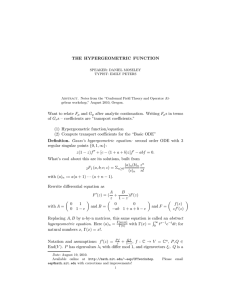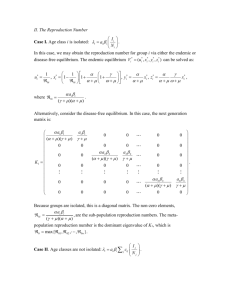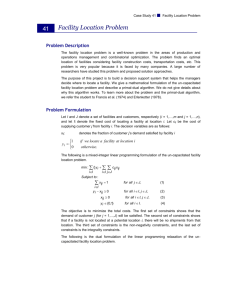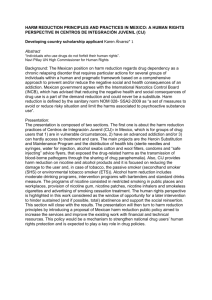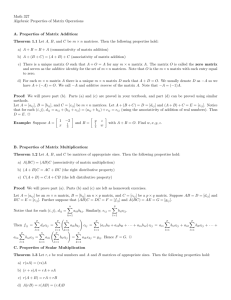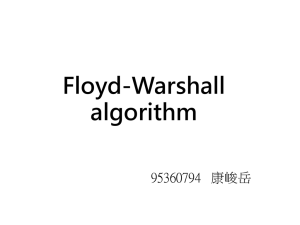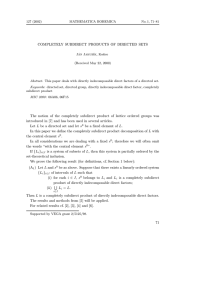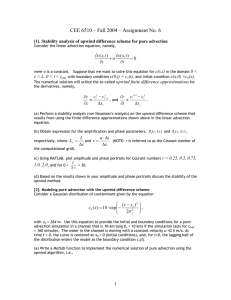Document 10905437
advertisement
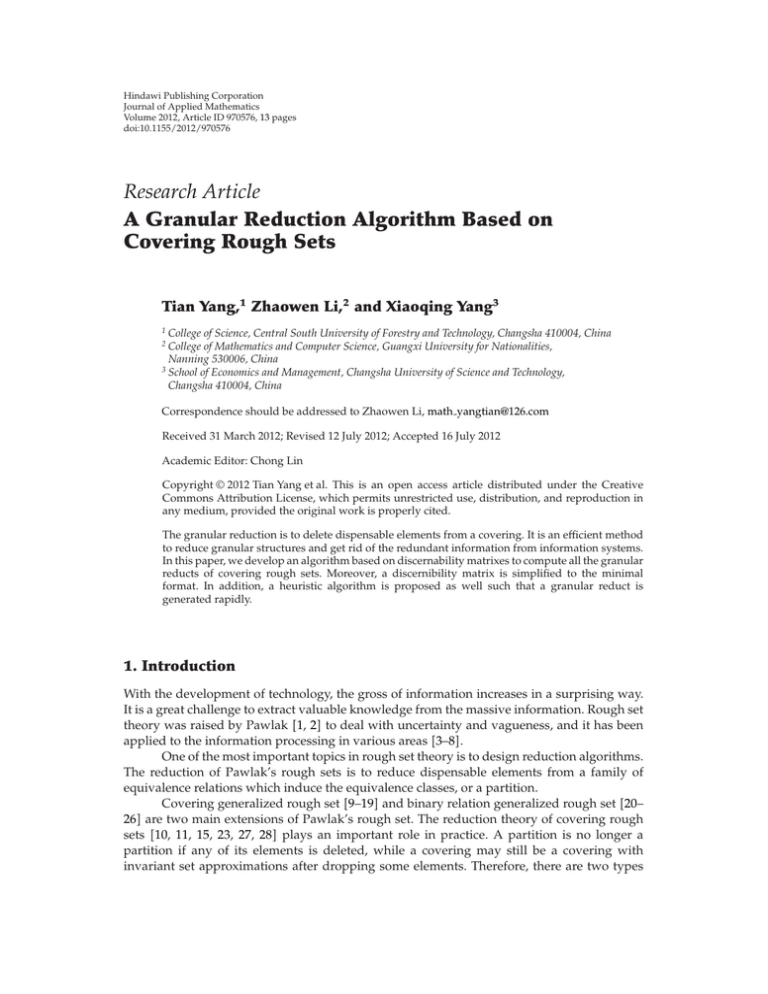
Hindawi Publishing Corporation
Journal of Applied Mathematics
Volume 2012, Article ID 970576, 13 pages
doi:10.1155/2012/970576
Research Article
A Granular Reduction Algorithm Based on
Covering Rough Sets
Tian Yang,1 Zhaowen Li,2 and Xiaoqing Yang3
1
College of Science, Central South University of Forestry and Technology, Changsha 410004, China
College of Mathematics and Computer Science, Guangxi University for Nationalities,
Nanning 530006, China
3
School of Economics and Management, Changsha University of Science and Technology,
Changsha 410004, China
2
Correspondence should be addressed to Zhaowen Li, math yangtian@126.com
Received 31 March 2012; Revised 12 July 2012; Accepted 16 July 2012
Academic Editor: Chong Lin
Copyright q 2012 Tian Yang et al. This is an open access article distributed under the Creative
Commons Attribution License, which permits unrestricted use, distribution, and reproduction in
any medium, provided the original work is properly cited.
The granular reduction is to delete dispensable elements from a covering. It is an efficient method
to reduce granular structures and get rid of the redundant information from information systems.
In this paper, we develop an algorithm based on discernability matrixes to compute all the granular
reducts of covering rough sets. Moreover, a discernibility matrix is simplified to the minimal
format. In addition, a heuristic algorithm is proposed as well such that a granular reduct is
generated rapidly.
1. Introduction
With the development of technology, the gross of information increases in a surprising way.
It is a great challenge to extract valuable knowledge from the massive information. Rough set
theory was raised by Pawlak 1, 2 to deal with uncertainty and vagueness, and it has been
applied to the information processing in various areas 3–8.
One of the most important topics in rough set theory is to design reduction algorithms.
The reduction of Pawlak’s rough sets is to reduce dispensable elements from a family of
equivalence relations which induce the equivalence classes, or a partition.
Covering generalized rough set 9–19 and binary relation generalized rough set 20–
26 are two main extensions of Pawlak’s rough set. The reduction theory of covering rough
sets 10, 11, 15, 23, 27, 28 plays an important role in practice. A partition is no longer a
partition if any of its elements is deleted, while a covering may still be a covering with
invariant set approximations after dropping some elements. Therefore, there are two types
2
Journal of Applied Mathematics
of reduction on covering rough sets. One is to reduce redundant coverings from a family of
coverings, referred to as the attribute reduction. The other is to reduce redundant elements
from a covering, noted as the granular reduction. It is to find the minimal subsets of a covering
which generate the same set approximations with the original covering. Employed to reduce
granular structures and databases as well as interactive with the attribute reduction, we think
the granular reduction should be ignored by no means. In this paper, we devote to investigate
granular reduction of covering rough sets.
In order to compute all attribute reducts for Pawlak’s rough sets, discernibility
matrix is initially presented 29. Tsang et al. 15 develop an algorithm of discernibility matrices to compute attribute reducts for one type of covering rough sets.
Zhu and Wang 17 and Zhu 18 build one type of granular reduction for two covering
rough set models initially. In addition, Yang et al. systematically examine the granular
reduction in 30 and the relationship between reducts and topology in 31. Unfortunately,
no effective algorithm for granular reduction has hitherto been proposed.
In this paper, we bridge the gap by constructing an algorithm based on discernibility
matrixes which is applicable to all granular reducts of covering rough sets. This algorithm
can reduce granular structures and get rid of the redundant information from information
systems. Then a discernibility matrix is simplified to the minimal format. Meanwhile, based
on a simplification of discernibility matrix, a heuristic algorithm is proposed as well.
The remainder of this paper proceeds as follows. Section 2 reviews the relevant
background knowledge about the granular reduction. Section 3 constructs the algorithm
based on discernibility matrix. Section 4 simplifies the discernibility matrix and proposes a
heuristic algorithm. Section 5 concludes the study.
2. Background
Our aim in this section is to give a glimpse of rough set theory.
Let U be a finite and nonempty set, and let R be an equivalence relation on U. R
generates a partition U/R {xR | x ∈ X} on U, where xR is an equivalence class of x
generated by the equivalence relation R. We call it elementary sets of R in rough set theory.
For any set X, we describe X by the elementary sets of R, and the two sets
R∗ ∪{xR | xR ⊆ X},
R∗ ∪{xR | xR ∩ X /
∅}
2.1
are called the lower and upper approximations of X, respectively. If R∗ X R∗ X, X is an
R-exact set. Otherwise, it is an R-rough set.
Let R be a family of equivalence relations, and let A ∈ R, denoted as INDR ∩{R : R ∈ R}. A is dispensable in R if and only if INDR INDR − A. Otherwise, A
is indispensable in R. The family R is independent if every A ∈ R is indispensable in R.
Otherwise, R is dependent. Q ∈ P is a reduct of P if Q is independent and INDQ INDP.
The sets of all indispensable relations in P are called the core of P, denoted as COREP.
Evidently, COREP ∩REDP, where REDP is the family of all reducts of P. The
discernibility matrix method is proposed to compute all reducts of information systems and
relative reducts of decision systems 29.
C is called a covering of U, where U is a nonempty domain of discourse, and C is a
family of nonempty subsets of U and ∪C U.
Journal of Applied Mathematics
3
It is clear that a partition of U is certainly a covering of U, so the concept of a covering
is an extension of the concept of a partition.
Definition 2.1 minimal description 9. Let C be a covering of U,
MdC x {K ∈ C | x ∈ K ∧ ∀S ∈ C ∧ x ∈ S ∧ S ⊆ K ⇒ K S}
2.2
is called the minimal description of x. When there is no confusion, we omit the C from the
subscript.
Definition 2.2 neighborhood 9, 19. Let C be a covering of U, and NC x ∩{C ∈ C |
x ∈ C} is called the neighborhood of x. Generally, we omit the subscript C when there is no
confusion.
Minimal description and neighborhood are regarded as related information granules
to describe x, which are used as approximation elements in rough sets as shown in
Definition 2.3. It shows that Nx ∩{C ∈ C | x ∈ C} ∩Mdx. The neighborhood of
x can be seen as the minimum description of x, and it is the most precise description more
details are referred to 9.
Definition 2.3 covering lower and upper approximation operations 19. Let C be a covering
of U. The operations CLC : P U → P U and CL C : P U → P U are defined as follows:
for all X ∈ P U,
CLC X ∪{K ∈ C | K ⊆ X} ∪{K | ∃x, s.t. K ∈ Mdx ∧ K ⊆ X},
CL C X {x | Nx ⊆ X} ∪{Nx | Nx ⊆ X}.
2.3
We call CLC the first, the second, the third, or the fourth covering lower approximation
operations and CL C the fifth, the sixth, or the seventh covering lower approximation
operations, with respect to the covering C.
The operations FH, SH, T H, RH, IH, XH, and V H : P U → P U are defined as
follows: for all X ∈ P U,
FHC X CLX ∪ ∪{Mdx | x ∈ X − CLX},
SHC X ∪{K | K ∈ C, K ∩ X / ∅},
T HC X ∪{Mdx | x ∈ X},
∅},
RHC X CLX ∪ ∪{K | K ∩ X − CLX /
IHC X CLX ∪ ∪{Nx | x ∈ X − CLX} ∪{Nx | x ∈ X},
∅},
XHC X {x | Nx ∩ X /
∅}.
V HC X ∪{Nx | Nx ∩ X /
2.4
4
Journal of Applied Mathematics
FHC , SHC , T HC , RHC , IHC , XHC , and V HC are called the first, the second, the third, the
fourth, the fifth, the sixth, and the seventh covering upper approximation operations with
respect to C, respectively. We leave out C at the subscript when there is no confusion.
As shown in 32, every approximation operation in Definition 2.3 may be applied
in certain circumstance. We choose the suitable approximation operation according to the
specific situation. So it is important to design the granular reduction algorithms for all of
these models.
More precise approximation spaces are proposed in 30. As a further result, a
reasonable granular reduction of coverings is also introduced. Let MC ∪{Mdx | x ∈ U},
NC {Nx | x ∈ U}. U, MC is the approximation space of the first and the third types of
covering rough sets, U, C is the approximation space of the second and the fourth types of
covering rough sets, and U, NC is the approximation space of the fifth, the sixth, and the
seventh types of covering rough sets referred to 30 for the details. In this paper, we design
the algorithm of granular reduction for the fifth, the sixth, and the seventh type of covering
rough sets.
Let C be a covering of U, denoting a covering approximation space. MC denotes an Mapproximation space. NC represents an N-approximation space. We omit C at the subscript
when there is no confusion referred to 30 for the details.
3. Discernibility Matrixes Based on Covering Granular Reduction
In the original Pawlak’s rough sets, a family of equivalence classes induced by equivalence
relations is a partition. Once any of its elements are deleted, a partition is no longer a partition.
The granular reduction refers to the method of reducing granular structures and to get rid of
redundant information in databases. Therefore, granular reduction is not applicable to the
original Pawlak’s rough sets. However, as one of the most extensions of Pawlak’s rough sets,
a covering is still working even subject to the omission of its elements, as long as the set
approximations are invariant. The purpose of covering granular reduction is to find minimal
subsets keeping the same set approximations. It is meaningful and necessary to develop the
algorithm for covering granular reduction.
The quintuple U, C, CL, CH is called a covering rough set system CRSS, where C is
a covering of U, CL and CH are the lower and upper approximation operations with respect
to the covering C, and U, AC is the approximation space. According to the categories of
covering approximation operations in 30, there are two kinds of situations as follows.
1 If AC C or AC MC , then AC ⊆ C: thus; AC is the unique granular reduct of C.
There is no need to develop an algorithm to compute granular reducts for the first,
the second, the third, and the fourth type of the covering rough sets.
2 If AC NC , generally, AC is not a subset of C. Consequently, an algorithm is needed
to compute all granular reducts of C for the fifth, the sixth, and the seventh type of
covering rough set models.
Next we examine the algorithm of granular reduction for the fifth, the sixth, and the
seventh type of covering rough sets. Let C be a covering of U, since NC {Nx | x ∈ U},
and NC is the collection of all approximation elements of the fifth, the sixth, or the seventh
type of lower/upper approximation operations. NC is called the N-approximation space
of C. Given a pair of approximation operations, the set approximations of any X ⊆ U are
Journal of Applied Mathematics
5
determined by the N-approximation spaces. Thus, for the fifth, the sixth, and the seventh
type of covering rough set models, the purpose of granular reduction is to find the minimal
subsets C of C such that NC NC . The granular reducts based on the N-approximation
spaces are called the N-reducts. NredC is the set of all N-reducts of C, and NIC is the set
of all N-irreducible elements of C referred to 30 for the details.
In Pawlak’s rough set theory, for every pair of x, y ∈ U, if y belongs to the equivalence
class containing x, we say that x and y are indiscernible. Otherwise, they are discernible. Let
R {R1 , R2 , . . . , Rn } be a family of equivalence relation on U, Ri ∈ R. Ri is indispensable in R
if and only if there is a pair of x, y ∈ U such that the relation between x and y is altered after
deleting Ri from R. The attribute reduction of Pawlak’s rough sets is to find minimal subsets
of R which keep the relations invariant for any x, y ∈ U. Based on this statement, the method
of discernibility matrix to compute all reducts of Pawlak’s rough sets was proposed in 29. In
covering rough sets, however, the discernibility relation between x, y ∈ U is different from
that in Pawlak’s rough sets.
Let C be a covering on U, x, y ∈ U × U. Then we call x, y indiscernible if
y ∈ Nx, that is, Ny ⊆ Nx. Otherwise, x, y is discernible. When C is a partition,
the new discernibility relation coincides with that in Pawlak’s. It is an extension of Pawlak’s
discernibility relation. In Pawlak’s rough sets, x, y is indiscernible if and only if y, x is
indiscernible. However, for a general covering, if Ny ⊆ Nx and Ny /
Nx, that is,
/ Ny, y, x is discernible while x, y is indiscernible. Thereafter, we call
y ∈ Nx and x ∈
these relations the relations of x, y with respect to C. The following theorem characterizes
these relations.
Proposition 3.1. Let C {Ci | i 1, 2, 3, . . . , n} be a covering on U, and let Cx {Ci ∈ C | x ∈ Ci }.
1 y ∈ Nx if and only if Cx ⊆ Cy .
/ Ci .
2 y ∈
/ Nx if and only if there is Ci ∈ C such that x ∈ Ci and y ∈
Proof. 1 y ∈ Nx ∩Cx ⇔ for any Ci ∈ Cx , y ∈ Ci ⇔ for any Ci ∈ Cx , Ci ∈ Cy ⇔ Cx ⊆ Cy .
2 It is evident from 1.
Theorem 3.2. Let C be a covering on U, Ci ∈ C. Then NC /
NC−{Ci } if and only if there is x, y ∈
U × U whose discernibility relation with respect to C is changed after deleting Ci from C.
Proof. Suppose that NC /
NC−{Ci } , then there is at least one element x ∈ U such that
NC−{Ci } x, that is, NC x ⊂ NC−{Ci } x. Since NC−{Ci } x − NC x /
∅, suppose that
NC x /
/ NC x. Namely, x, y is discernible
y ∈ NC−{Ci } x − NC x, then y ∈ NC−{Ci } x and y ∈
with respect to C, while x, y is indiscernible with respect to C − {Ci }.
Suppose that there is x, y ∈ U × U whose discernibility relation with respect to C is
changed after deleting Ci from C. Put differently, x, y is discernible with respect to C, while
/ NC x,
x, y is indiscernible with respect to C − {Ci }. Then we have y ∈ NC−{Ci } x and y ∈
NC−{Ci } x. It implies NC /
so y ∈ NC−{Ci } x − NC x. Thus, NC x /
NC−{Ci } .
The purpose of granular reducts of a covering C is to find the minimal subsets of
C which keep the same classification ability as C or, put differently, keep NC invariant.
In Theorem 3.2, NC is kept unchanged to make the discernibility relations of any x, y ∈
U × U invariant. Based on this statement, we are able to compute granular reducts with
discernibility matrix.
6
Journal of Applied Mathematics
Definition 3.3. Let U {x1 , x2 , . . . , xn }, C be a covering on U. MU, C is an n×n matrix cij n×n
called a discernibility matrix of U, C, where
1 cij ∅, xj ∈ Nxi ,
2 cij {C ∈ C | xi ∈ C, xj ∈
/ C}, xj ∈
/ Nxi .
This definition of discernibility matrix is more concise than the one in 11, 15
due to the reasonable statement of the discernibility relations. Likewise, we restate the
characterizations of N-reduction.
Proposition 3.4. Consider that NIC {C | cij {C} for some cij ∈ MU, C}.
Proof. For any C ∈ NIC, NC /
NC−{C} , then there is xi , xj ∈ U×U such that xj ∈ NC−{C} xi / NC xi . It implies that xi ∈ C and xj ∈
/ C. Moreover, for any C ∈ C − {C}, since
and xj ∈
xj ∈ NC−{C} xi , we have xi ∈ C if xi ∈ C . Thus, cij {C}.
/ C. And for any C ∈ C − {C},
If cij {C} for some cij ∈ MU, C, then xi ∈ C and xj ∈
/ NC xi , then NC−{C} xi if xi ∈ C , then xi ∈ C , that is, xj ∈ NC−{C} xi and xj ∈
/ NC xi .
,
which
implies
C
∈
NIC.
N
Namely, NC / C−{C}
Proposition 3.5. Suppose that C ⊆ C, then NC NC if and only if C ∩ cij /
∅ for every cij /
∅.
Proof. NC NC
⇔ for any xi , xj ∈ U × U, xj ∈
/ NC xi if and only if xj ∈
/ NC xi ,
⇔ for any xi , xj ∈ U × U, there is C ∈ C such that xi ∈ C and xj ∈
/ C if and only if
/ C ,
there is C ∈ C such that xi ∈ C and xj ∈
⇔ for any cij /
∅, C /
∅.
Proposition 3.6. Suppose that C ⊆ C, then C ∈ NredC if and only if C is a minimal set satisfying
∅ for every cij /
∅.
C ∩ cij /
Definition 3.7. Let U {x1 , x2 , . . . , xn }, let C {C1 , C2 , . . . , Cm } be a covering of U, and let
MU, C cij n×n be the discernibility matrix of U, C. A discernibility function fU, C
is a Boolean function of m Boolean variables, C1 , C2 , . . . , Cm , corresponding to the covering
elements C1 , C2 , . . . , Cm , respectively, defined as fU, CC1 , C2 , . . . , Cm ∧{∨cij | cij ∈
∅}.
MU, C, cij /
Theorem 3.8. Let C be a family of covering on U, let fU, C be the discernibility function, and
let gU, C be the reduced disjunctive form of fU, C by applying the multiplication and absorption
laws. If gU, C ∧C1 ∨ · · · ∨ ∧Cl , where Ck ⊆ C, k 1, 2, . . . , l and every element in Ck only
appears once, then NredC {C1 , C2 , . . . , Cl }.
Proof. For every k 1, 2, . . . , l, ∧Ck ≤ ∨cij for any cij ∈ MU, C, so Ck ∩ cij /
∅. Let Ck Ck −
k−1
l
{C} for any C ∈ Ck , then gU, C ∨t1 ∧Ct ∨∧Ck ∨∨tk1 ∧Ct . If for every cij ∈ MU, C,
k−1
we have Ck ∩ cij / ∅, then ∧Ck ≤ ∨cij for every cij ∈ MU, C, that is, gU, C ≥ ∨t1 ∧Ct ∨
∧Ck ∨∨ltk1 ∧Ct , which is a contradiction. It implies that there is ci0 j0 ∈ MU, C such that
Ck ∩ ci0 j0 ∅. Thus, Ck is a reduct of C.
Journal of Applied Mathematics
7
Table 1
Objects
x1
x2
x3
x4
x5
x6
C1
∗
∗
∗
C2
∗
∗
C3
∗
∗
∗
C4
∗
C5
∗
∗
∗
∗
C6
∗
∗
∗
C7
∗
∗
∗
∗
For any C ∈ RedC, we have C ∩ cij /
∅ for every cij ∈ MU, C, so fU, C ∧ ∧C ∧∨cij ∧ ∧C ∧C , which implies ∧C ≤ fU, C gU, C. Suppose that, for every k ∅, then for every k, there is Ck ∈ Ck − C . By rewriting gU, C 1, 2, . . . , l, we have Ck − C /
l
l
∨k1 Ck ∧ Φ, ∧C ≤ ∨k1 Ck . Thus, there is Ck0 such that ∧C ≤ Ck0 , that is, Ck0 ∈ C , which is a
contradiction. So Ck0 ⊆ C for some k0 , since both C and Ck0 are reducts, and it is evident that
C Ck0 . Consequently, RedC {C1 , C2 , . . . , Cl }.
Algorithm 3.9. Consider the following:
input: U, C,
output: NredC and NIC// The set of all granular reducts and the set of all Nirreducible elements.
Step 1: MU, Ccij n×n , for each cij , let cij ∅.
Step 2: for each xi ∈ U, compute Nxi ∩{C ∈ C | xi ∈ C}.
/ Nxi , cij {C ∈ C | xi ∈ C, xj ∈
/ C}.
If xj ∈
∅}.
Step 3: fU, CC1 , C2 , . . . , Cm ∧{∨cij | cij ∈ MU, C, cij /
Step 4: compute fU, C to gU, C ∧C1 ∨ · · · ∨ ∧Cl // where Ck ⊆ C,
k 1, 2, . . . , l, and every element in Ck only appears once.
Step 4: output NredC {C1 , C2 , . . . , Cl }, NIC ∩NredC.
Step 5: end.
The following example is used to illustrate our idea.
Example 3.10. Suppose that U {x1 , x2 , . . . , x6 }, where xi , i 1, 2, . . . , 6 denote six objects,
and let Ci , i 1, 2, . . . , 7 denote seven properties; the information is presented in Table 1, that
is, the ith object possesses the jth attribute is indicated by a ∗ in the ij-position of the table.
{x1 , x2 , x3 } is the set of all objects possessing the attribute C1 , and it is denoted by
C1 {x1 , x2 , x3 }. Similarly, C2 {x1 , x4 }, C3 {x3 , x4 , x5 }, C4 {x1 , x4 , x5 }, C5 {x1 , x4 , x6 },
C6 {x3 , x4 }, and C7 {x1 , x4 , x5 , x6 }. Evidently, C {C1 , C2 , C3 , C4 , C5 , C6 , C7 } is a covering
on U.
Then, Nx1 {x1 }, Nx2 {x1 , x2 , x3 }, Nx3 {x3 }, Nx4 {x4 }, Nx5 {x4 , x5 }, and Nx6 {x4 , x6 }.
8
Journal of Applied Mathematics
Table 2
Objects
x1
x2
x3
x4
x5
x6
C1
∗
∗
∗
C3
∗
∗
∗
C4
∗
C5
∗
∗
∗
∗
∗
Table 3
Objects
x1
x2
x3
x4
x5
x6
C1
∗
∗
∗
C3
∗
∗
∗
C5
∗
C7
∗
∗
∗
∗
∗
∗
The discernibility matrix of U, C is exhibited as follows:
⎛
⎞
∅
{C2 , C4 , C5 , C7 }
{C2 , C4 , C5 , C7 } {C1 } {C1 , C2 , C5 } {C1 , C2 , C4 }
⎜ ∅
⎟
∅
∅
{C1 }
{C1 }
{C1 }
⎜
⎟
⎜{C , C }
∅
{C3 , C6 }
{C1 } {C1 , C6 }
{C1 , C3 , C6 } ⎟
⎜ 3 6
⎟
⎜
⎟,
⎜{C3 , C6 } {C2 , C3 , C4 , C5 , C6 , C7 } {C2 , C4 , C5 , C7 } ∅ {C2 , C5 , C6 } {C2 , C3 , C4 , C6 }⎟
⎜
⎟
⎝ {C3 }
⎠
∅
∅
{C3 , C4 , C7 }
{C4 , C7 }
{C3 , C4 }
∅
∅
∅
{C5 , C7 }
{C5 , C7 }
{C5 }
3.1
fU, Δ C1 , C2 , C3 , C4 , C5 , C6 , C7
∧ ∨ cij | i, j 1, 2, . . . , 6, cij /
∅
C2 ∨ C4 ∨ C5 ∨ C7 ∧ C2 ∨ C4 ∨ C5 ∨ C7 ∧ C1 ∧ C1 ∨ C2 ∨ C5 ∧ C1 ∨ C2 ∨ C4 ∧ C1 ∧ C1 ∧ C1 ∧ C3 ∨ C6 ∧ C3 ∨ C6 ∧ C1 ∧ C1 ∨ C6 ∧ C1 ∨ C3 ∨ C6 ∧ C3 ∨ C6 ∧ C2 ∨ C3 ∨ C4 ∨ C5 ∨ C6 ∨ C7 ∧ C2 ∨ C4 ∨ C5 ∨ C7 ∧ C2 ∨ C5 ∨ C6 ∧ C2 ∨ C3 ∨ C4 ∨ C6 ∧ C3 ∧ C3 ∨ C4 ∨ C7 ∧ C4 ∨ C7 ∧ C3 ∨ C4 ∧ C5 ∨ C7 ∧ C5 ∨ C7 ∧ C5
C5 ∧ C1 ∧ C3 ∧ C4 ∨ C5 ∧ C1 ∧ C3 ∧ C7 .
3.2
So NredC {{C1 , C3 , C4 , C5 }, {C1 , C3 , C5 , C7 }}, NIC {C1 , C3 , C5 }. As a result,
Table 1 can be simplified into Table 2 or Table 3, and the ability of classification is invariant.
Obviously, the granular reduction algorithm can reduce data sets as shown.
Journal of Applied Mathematics
9
4. The Simplification of Discernibility Matrixes
For the purpose of finding the set of all granular reducts, we have proposed the method
by discernibility matrix. Unfortunately, it is at least an NP problem, since the discernibility
matrix in this paper is more complex than the one in 33. Accordingly, we simplify the
discernibility matrixes in this section. In addition, a heuristic algorithm is presented to avoid
the NP hard problem.
Definition 4.1. Let MU, C cij n×n be the discernibility matrix of U, C. For any cij ∈
MU, C, if there is an nonempty element ci0j0 ∈ MU, C − {cij } such that ci0j0 ⊆ cij , let
cij ∅; otherwise, cij cij , then we get a new discernibility matrix SIMU, C cij ,
n×n
which called the simplification discernibility matrix of U, C.
Theorem 4.2. Let MU, C be the discernibility matrix of U, C, and SIMU, C is the simplification
∅ for any nonempty element cij ∈ MU, C if and only
discernibility matrix, C ⊆ C. Then C ∩ cij /
∅ for any nonempty element cij ∈ SIMU, C.
if C ∩ cij /
Proof. If C ∩ cij /
∅ for every cij /
∅ and cij ∈ MU, C, it is evident that C ∩ cij /
∅ for every
∈
SIMU,
C.
cij ∅
and
c
/
ij
Suppose that C ∩ cij /
∅ for every cij /
∅ and cij ∈ SIMU, C. For any nonempty cij ∈
MU, C, if there is an nonempty element ci0j0 ∈ MU, C − {cij } such that ci0j0 ⊆ cij , and
ci0j0 for any nonempty element ci1j1 ∈ MU, C − {cij , ci0j0 }, ci1j1 ⊆
/ci0j0 , then ci0j0
/ ∅. Since
⊆cij for any nonempty element ci0j0 ∈
C ∩ ci0j0 /
∅, then C ∩ ci0j0 /
∅; thus, C ∩ cij /
∅. If ci0j0 /
MU, C − {cij }, then cij cij . Since C ∩ cij ∩ cij ∅,
then
C
/
/ ∅. Thus, C ∩ cij / ∅ for every
nonempty cij ∈ MU, C.
Proposition 4.3. Suppose that C ⊆ C, then C ∈ NredC if and only if C is a minimal set satisfying
C ∩ cij / ∅ for every cij / ∅ and cij ∈ SIMU, C.
Proposition 4.4. Consider that ∪{cij | cij ∈ SIMU, C} ∪NredC.
Proof. Suppose that C ∈ ∪{cij | cij ∈ SIMU, C}, then there is cij ∈ SIMU, C such that C ∈ cij
and cij ∩ NIC ∅. For any cij ∈ SIMU, C, if C ∈ cij , let cij1 {C}. Otherwise, cij1 {Cij },
where Cij ∈ cij . Suppose that M1 U, C cij1 ; it is easy to prove that C ∈ ∪{cij1 | cij1 ∈
n×n
M1 U, C} ∈ NredC. Thus, C ∈ ∪NredC.
Suppose that C ∈ ∪NredC, then there is Ck ∈ NredC such that C ∈ Ck . From
∅ for every cij /
∅ and
Proposition 4.3, we know that Ck is a minimal set satisfying Ck ∩ c ij /
cij ∈ SIMU, C. So there is a cij ∈ SIMU, C such that C ∈ cij , or else C is redundant in Ck .
Thus, C ∈ ∪{cij | cij ∈ SIMU, C}.
In summary, ∪{cij | cij ∈ SIMU, C} ∪NredC.
be the simplified discernibility matrix of U, C, then
Proposition 4.5. Let SIMU, C cij n×n
SIMU, C is the minimal matrix to compute all granular reducts of C, that is, for any matrix
M0 U, C dij n×n where dij ⊆ cij , M0 U, C can compute all granular reducts of C if and only if
dij cij for 1 ≤ i, j ≤ n.
Proof. If dij cij for 1 ≤ i, j ≤ n, then M0 U, C SIMU, C, and M0 U, C can compute all
granular reducts of C.
10
Journal of Applied Mathematics
∈ SIMU, C such that di0j0 ⊂ ci0j0
. If |ci0j0
| Suppose that there is a nonempty ci0j0
1, suppose that ci0j0
{C0 }, then di0j0 ∅. From the definition of the simplification
discernibility matrix, we know that C0 ∈
/ cij for any cij ∈ SIMU, C − {ci0j0
}, then C0 ∈
/ dij
for any dij ∈ M0 U, C. So M0 U, C cannot compute any granular reducts of C. If |ci0j0
| ≥ 2,
1
− di0j0 , and let ci0j0
{C}. For any
we suppose that di0j0 /
∅. Then there is a C ∈ ci0j0
1
1
. Let
cij ∈ SIMU, C−{ci0j0 }, if C ∈ cij , let cij ∅. Otherwise, let cij {Cij } where Cij ∈ cij −ci0j0
1
1
1
and C ∪{cij | cij ∈ M1 U, C}, and it is easy to prove that C ∈ NredC.
M1 U, C cij n×n
However, C ∩ di0j0 ∅, that is, M0 U, C cannot compute all granular reducts of C. Thus, if
M0 U, C can compute all granular reducts of C, then dij cij for 1 ≤ i, j ≤ n.
From the above propositions, we know that the simplified discernibility matrix is
the minimal discernibility matrix which can compute the same reducts as the original one.
Hereafter, we only examine simplified discernibility matrixes instead of general discernibility
matrixes. The following example is used to illustrate our idea.
Example 4.6. The discernibility matrix of U, C in Example 3.10 is as follows:
⎛
⎞
∅ {C5 }
∅
{C1 } ∅ ∅
⎜ ∅
∅
∅
∅ ∅ ∅⎟
⎜
⎟
⎜{C } ∅
∅
∅ ∅ ∅⎟
⎜ 3
⎟
⎜
⎟,
⎜ ∅
∅
∅
∅ ∅ ∅⎟
⎜
⎟
⎝ ∅
∅ {C4 , C7 } ∅ ∅ ∅⎠
∅
∅
∅
∅ ∅ ∅
fU, Δ C1 , C2 , C3 , C4 , C5 , C6 , C7 ∧ ∨ cij | i, j 1, 2, . . . , 6, cij /
∅
4.1
C5 ∧ C1 ∧ C3 ∧ C4 ∨ C7 C5 ∧ C1 ∧ C3 ∧ C4 ∨ C5 ∧ C1 ∧ C3 ∧ C7 .
So NredC {{C1 , C3 , C4 , C5 }, {C1 , C3 , C5 , C7 }}, NIC {C1 , C3 , C5 }.
From the above example, it is easy to see that simplified discernibility matrix can
simplify the computing processes remarkably. Especially when C is a consistent covering
proposed in 30, that is, NredC {NIC}, the unique reduct NredC {∪{cij | cij ∈
SIMU, C}}.
Unfortunately, although the simplified discernibility matrixes are more simple, the
processes of computing reducts by discernibility function are still NP hard. Accordingly, we
develop a heuristic algorithm to obtain a reduct from a discernibility matrix directly.
Let MU, C cij n×n be a discernibility matrix. We denote the number of the elements
in cij by |cij |. For any C ∈ C, ||C|| denotes the number of cij which contain C. Let cij ∈ MU, C,
if for any C ∈ NIC, C ∈
/ cij , then cij cij . Since ∪{cij | |cij | ≥ 2} ∪NredC − NIC, if
|cij | ≥ 2, then the elements in cij may either be deleted from C or be preserved. Suppose
that C0 ∈ ∪{cij | |cij | ≥ 2}, if ||C0 || ≥ ||C|| for any C ∈ ∪{cij | |cij | ≥ 2}, C0 is called the
maximal element with respect to the simplified discernibility matrix SIMU, C. The heuristic
algorithm to get a reduct from a discernibility matrix directly proceeds as follows.
Journal of Applied Mathematics
11
Algorithm 4.7. Consider the following:
input: U, C,
output: granular reducts red
Step 1: MU, Ccij n×n , for each cij , let cij ∅.
Step 2: for each xi ∈ U, compute Nxi ∩{C ∈ Cxi ∈ C}.
If xj ∈
/ Nxi ,
cij {C ∈ C | xi ∈ C, xj ∈
/ C}//get the discernibility matrix.
Step 3: for each cij ∈ MU, C,
if there is a nonempty element ci0j0 ∈ MU, C − {cij } such that
ci0j0 ⊆ cij , let cij ∅ // get the simplified discernibility matrix.
Step 4: for each Ci ∈ ∪MU, C, compute ||Ci || and select the maximal
element C0 of SIMU, C.
For each cij ∈ MU, C,
if C0 ∈ cij ,
let cij {C0 }.
Step 5: if there is cij ∈ MU, C such that |cij | 2,
return to Step 3;
else
output red ∪MU, C.
Step 5: end.
Example 4.8. The simplified discernibility matrix of U, C in Example 3.10 is as follows:
⎛
∅ {C5 }
∅
{C1 }
⎜ ∅
∅
∅
∅
⎜
⎜{C } ∅
∅
∅
⎜ 3
⎜
⎜ ∅
∅
∅
∅
⎜
⎝ ∅
∅ {C4 , C7 } ∅
∅
∅
∅
∅
∅
∅
∅
∅
∅
∅
⎞
∅
∅⎟
⎟
∅⎟
⎟
⎟.
∅⎟
⎟
∅⎠
∅
4.2
1
For a maximal element C4 of SIMU, C, let c53
{C4 }, then we get M1 U, C as follows:
⎛
∅ {C5 } ∅ {C1 }
⎜ ∅
∅
∅
∅
⎜
⎜{C } ∅
∅
∅
⎜ 3
⎜
⎜ ∅
∅
∅
∅
⎜
⎝ ∅
∅ {C4 } ∅
∅
∅
∅
∅
∅
∅
∅
∅
∅
∅
⎞
∅
∅⎟
⎟
∅⎟
⎟
⎟.
∅⎟
⎟
∅⎠
∅
Thus, {C1 , C3 , C4 , C5 } ∪{cij1 | cij1 ∈ M1 U, C} is a granular reduct of C.
4.3
12
Journal of Applied Mathematics
1
{C7 }, then we get M2 U, C as follows:
For a maximal element C7 of SIMU, C, let c53
⎛
∅ {C5 } ∅ {C1 }
⎜ ∅
∅
∅
∅
⎜
⎜{C } ∅
∅
∅
⎜ 3
⎜
⎜ ∅
∅
∅
∅
⎜
⎝ ∅
∅ {C7 } ∅
∅
∅
∅
∅
∅
∅
∅
∅
∅
∅
⎞
∅
∅⎟
⎟
∅⎟
⎟
⎟.
∅⎟
⎟
∅⎠
∅
4.4
Thus, {C1 , C3 , C5 , C7 } ∪{cij2 | cij2 ∈ M2 U, C} is also a granular reduct of C.
From the above example, we show that the heuristic algorithm can avoid the NP hard
problem and generate a granular reduct from the simplified discernability matrix directly.
With the heuristic algorithm, the granular reduction theory based on discernability matrix is
no longer limited to the theoretic level but applicable in practical usage.
5. Conclusion
In this paper, we develop an algorithm by discernability matrixes to compute all the granular
reducts with covering rough sets initially. A simplification of discernibility matrix is proposed
for the first time. Moreover, a heuristic algorithm to compute a granular reduct is presented
to avoid the NP hard problem in granular reduction such that a granular reduct is generated
rapidly.
Acknowledgments
This work is supported by National Natural Science Foundation of China under Grant no.
11201490 and no. 11061004, Science and Technology Plan Projects of Hunan Province no.
2011FJ3152.
References
1 Z. Pawlak, “Rough sets,” International Journal of Computer and Information Sciences, vol. 11, no. 5, pp.
341–356, 1982.
2 Z. Pawlak, Rough Sets: Theoretical Aspects of Reasoning about Data, Kluwer Acedemic, Boston, Mass,
USA, 1991.
3 G. Dong, J. Han, J. Lam, J. Pei, K. Wang, and W. Zou, “Mining constrained gradients in large
databases,” IEEE Transactions on Knowledge and Data Engineering, vol. 16, no. 8, pp. 922–938, 2004.
4 S. Pal and P. Mitra, “Case generation using rough sets with fuzzy representation,” IEEE Transactions
on Knowledge and Data Engineering, vol. 16, no. 3, pp. 292–300, 2004.
5 L. Polkowski and A. Skowron, Rough Sets and Current Trends in Computing, vol. 1424, Springer, Berlin,
Germany, 1998.
6 L. Polkowski and A. Skowron, Eds., Rough Sets in Knowledge Discovery, vol. 1, Physica-Verlag, Berlin,
Germany, 1998.
7 L. Polkowski and A. Skowron, Eds., Rough Sets in Knowledge Discovery, vol. 2, Physica-Verlag, Berlin,
Germany, 1998.
8 N. Zhong, Y. Yao, and M. Ohshima, “Peculiarity oriented multidatabase mining,” IEEE Transactions
on Knowledge and Data Engineering, vol. 15, no. 4, pp. 952–960, 2003.
Journal of Applied Mathematics
13
9 Z. Bonikowski, E. Bryniarski, and U. Wybraniec-Skardowska, “Extensions and intentions in the rough
set theory,” Information Sciences, vol. 107, no. 1–4, pp. 149–167, 1998.
10 E. Bryniarski, “A calculus of rough sets of the first order,” Bulletin of the Polish Academy of Sciences, vol.
37, no. 1–6, pp. 71–78, 1989.
11 C. Degang, W. Changzhong, and H. Qinghua, “A new approach to attribute reduction of consistent
and inconsistent covering decision systems with covering rough sets,” Information Sciences, vol. 177,
no. 17, pp. 3500–3518, 2007.
12 C. Degang, Z. Wenxiu, D. Yeung, and E. C. C. Tsang, “Rough approximations on a complete
completely distributive lattice with applications to generalized rough sets,” Information Sciences, vol.
176, no. 13, pp. 1829–1848, 2006.
13 T.-J. Li, Y. Leung, and W.-X. Zhang, “Generalized fuzzy rough approximation operators based on
fuzzy coverings,” International Journal of Approximate Reasoning, vol. 48, no. 3, pp. 836–856, 2008.
14 T.-J. Li and W.-X. Zhang, “Rough fuzzy approximations on two universes of discourse,” Information
Sciences, vol. 178, no. 3, pp. 892–906, 2008.
15 E. C. C. Tsang, C. Degang, and D. S. Yeung, “Approximations and reducts with covering generalized
rough sets,” Computers & Mathematics with Applications, vol. 56, no. 1, pp. 279–289, 2008.
16 E. Tsang, D. Chen, J. Lee, and D. S. Yeung, “On the upper approximations of covering generalized
rough sets,” in Proceedings of the 3rd International Conference on Machine Learning and Cybernetics, pp.
4200–4203, 2004.
17 W. Zhu and F.-Y. Wang, “Reduction and axiomization of covering generalized rough sets,” Information
Sciences, vol. 152, pp. 217–230, 2003.
18 W. Zhu, “Topological approaches to covering rough sets,” Information Sciences, vol. 177, no. 6, pp.
1499–1508, 2007.
19 W. Zhu, “Relationship between generalized rough sets based on binary relation and covering,”
Information Sciences, vol. 179, no. 3, pp. 210–225, 2009.
20 X. Y. Chen and Q. G. Li, “Construction of rough approximations in fuzzy setting,” Fuzzy Sets and
Systems, vol. 158, no. 23, pp. 2641–2653, 2007.
21 T. Y. Lin, “Topological and fuzzy rough sets,” in Intelligent Decision Support: Handbook of Applications
and Advances of the Rough Set Theory, R. Slowinsk, Ed., pp. 287–304, Kluwer Acedemic, Boston, Mass,
USA, 1992.
22 A. Skowron and J. Stepaniuk, “Tolerance approximation spaces,” Fundamenta Informaticae, vol. 27, no.
2-3, pp. 245–253, 1996.
23 C. Wang, C. Wu, and D. Chen, “A systematic study on attribute reduction with rough sets based on
general binary relations,” Information Sciences, vol. 178, no. 9, pp. 2237–2261, 2008.
24 Y. Y. Yao, “On generalizing pawlak approximation operators,” in LNAI, vol. 1424, pp. 298–307, 1998.
25 Y. Y. Yao, “Constructive and algebraic methods of the theory of rough sets,” Information Sciences, vol.
109, no. 1–4, pp. 21–47, 1998.
26 Y. Y. Yao, “Relational interpretations of neighborhood operators and rough set approximation
operators,” Information Sciences, vol. 111, no. 1–4, pp. 239–259, 1998.
27 F. Hu, G. y. Wang, H. Huang et al., “Incremental attribute reduction based on elementary sets,”
RSFDGrC, vol. 36, no. 41, pp. 185–193, 2005.
28 R. Jensen and Q. Shen, “Semantics-preserving dimensionality reduction: rough and fuzzy-roughbased approaches,” IEEE Transactions on Knowledge and Data Engineering, vol. 16, no. 12, pp. 1457–1471,
2004.
29 A. Skowron and C. Rauszer, “The discernibility matrices and functions in information systems,
intelligent decision suport,” in Handbook of Applications and Advances of the Rough Sets Theory, R.
Slowinski, Ed., Kluwer Academic, Boston, Mass, USA, 1992.
30 T. Yang and Q. G. Li, “Reduction about approximation spaces of covering generalized rough sets,”
International Journal of Approximate Reasoning, vol. 51, no. 3, pp. 335–345, 2010.
31 T. Yang, Q. G. Li, and B. L. Zhou, “Granular reducts from the topological view of covering rough
sets,” in Proceedings of the 8th IEEE International Conference on Granular Computing, Zhejiang University,
Hangzhou, China, August 2012.
32 T. Yang, Q. G. Li, and B. L. Zhou, “Related family: a new method for attribute reduction of covering
information systems,” Information Sciences. In press.
33 S. K. M. Wong and W. Ziarko, “On optimal decision rules in decision tables,” Bulletin of the Polish
Academy of Sciences, vol. 33, no. 11-12, pp. 693–696, 1985.
Advances in
Operations Research
Hindawi Publishing Corporation
http://www.hindawi.com
Volume 2014
Advances in
Decision Sciences
Hindawi Publishing Corporation
http://www.hindawi.com
Volume 2014
Mathematical Problems
in Engineering
Hindawi Publishing Corporation
http://www.hindawi.com
Volume 2014
Journal of
Algebra
Hindawi Publishing Corporation
http://www.hindawi.com
Probability and Statistics
Volume 2014
The Scientific
World Journal
Hindawi Publishing Corporation
http://www.hindawi.com
Hindawi Publishing Corporation
http://www.hindawi.com
Volume 2014
International Journal of
Differential Equations
Hindawi Publishing Corporation
http://www.hindawi.com
Volume 2014
Volume 2014
Submit your manuscripts at
http://www.hindawi.com
International Journal of
Advances in
Combinatorics
Hindawi Publishing Corporation
http://www.hindawi.com
Mathematical Physics
Hindawi Publishing Corporation
http://www.hindawi.com
Volume 2014
Journal of
Complex Analysis
Hindawi Publishing Corporation
http://www.hindawi.com
Volume 2014
International
Journal of
Mathematics and
Mathematical
Sciences
Journal of
Hindawi Publishing Corporation
http://www.hindawi.com
Stochastic Analysis
Abstract and
Applied Analysis
Hindawi Publishing Corporation
http://www.hindawi.com
Hindawi Publishing Corporation
http://www.hindawi.com
International Journal of
Mathematics
Volume 2014
Volume 2014
Discrete Dynamics in
Nature and Society
Volume 2014
Volume 2014
Journal of
Journal of
Discrete Mathematics
Journal of
Volume 2014
Hindawi Publishing Corporation
http://www.hindawi.com
Applied Mathematics
Journal of
Function Spaces
Hindawi Publishing Corporation
http://www.hindawi.com
Volume 2014
Hindawi Publishing Corporation
http://www.hindawi.com
Volume 2014
Hindawi Publishing Corporation
http://www.hindawi.com
Volume 2014
Optimization
Hindawi Publishing Corporation
http://www.hindawi.com
Volume 2014
Hindawi Publishing Corporation
http://www.hindawi.com
Volume 2014
